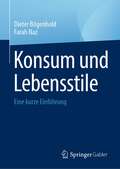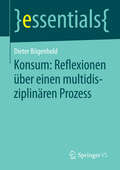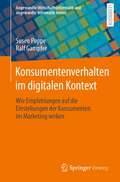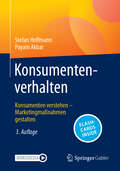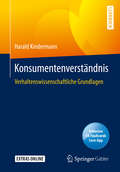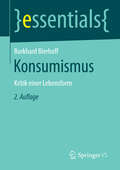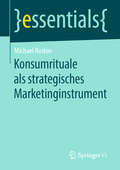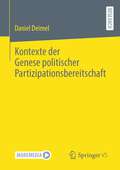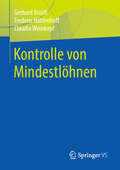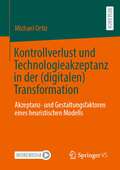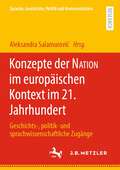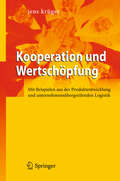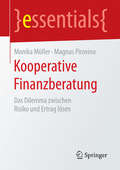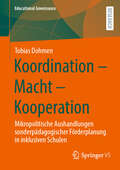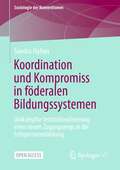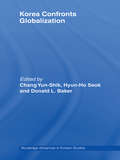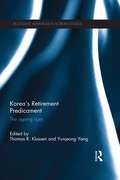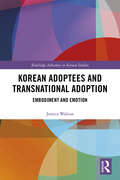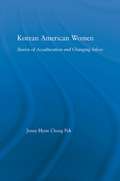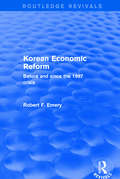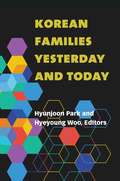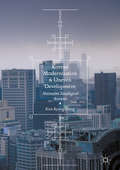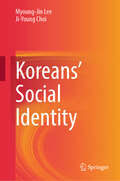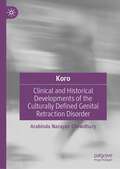- Table View
- List View
Konsum und Lebensstile: Eine kurze Einführung
by Dieter Bögenhold Farah NazIn diesem Buch wird ein interdisziplinärer Ansatz für die Welt des Konsums gewählt, der verschiedene Themen abdeckt und soziologische, wirtschaftliche und marketingbezogene Aspekte einbezieht. Der Begriff "Konsum" ist vage, und selbst in den akademischen Disziplinen wird der Begriff auf unterschiedliche Weise verwendet. Die Konsumforschung fragt, wie Einkommen und Ausgaben miteinander zusammenhängen. Ganz allgemein untersucht die Konsumforschung, wie Menschen, soziale Schichten oder Gesellschaften ihre Konsumgewohnheiten realisieren. Häufig wird die Frage gestellt, wie konsistent Präferenzstrukturen aufgrund wechselnder empirischer Hintergründe von Zeit, Raum und damit verbundener Kultur sind. Welche Kontextvariablen (historischer Zeitpunkt, geographischer Rahmen, kultureller Hintergrund) spezifizieren die Praxis des Konsums und in welcher Weise haben Merkmale wie Alter, Geschlecht, Klasse, Beruf und Lebensstil eigene Auswirkungen auf die Art und Weise, wie Konsum realisiert wird?Das Buch ist für Forscher aus den Bereichen Ökonomie, Soziologie, Marketing, Ästhetik und Design, Anthropologie und Kommunikationswissenschaft von Interesse.
Konsum: Reflexionen über einen multidisziplinären Prozess (essentials)
by Dieter BögenholdDieter Bögenhold nähert sich dem Thema Konsum aus soziologischer Perspektive und bezieht dabei wirtschaftswissenschaftliche Themen wie Marketing und Konsumökonomik sowie andere angrenzende Fachgebiete ein. Der Leser bekommt auf diese Weise einen Überblick über die vielen Facetten dieses Forschungsbereiches. Die Rolle des Konsums in der Ideengeschichte wird ebenso angesprochen wie das Verhältnis zwischen Konsum und Mode oder die ,,McDonaldisierung" des Konsums.
Konsumentenverhalten im digitalen Kontext: Wie Empfehlungen auf die Einstellungen der Konsumenten im Marketing wirken (Angewandte Wirtschaftsinformatik und angewandte Informatik lernen)
by Susen Poppe Ralf GampferDieses Buch gibt einen ersten Einblick in die Grundlagen des Marketings, insbesondere des Konsumentenverhaltens und betrachtet anschließend, inwieweit sich der digitale Kontext speziell auf das Thema Konsumentenverhaltensforschung auswirkt. Im Fokus des Interesses steht dabei die Einstellungsforschung. Diese wird hinsichtlich ihrer Besonderheiten im Kontext der fortwährenden Digitalisierung aller Lebensbereiche betrachtet. Damit schafft es dieses Buch, neben einer Einführung in das Marketing und das Konsumentenverhalten, die beiden Themenkomplexe, digitaler Kontext und Konsumentenverhaltensforschung, gemeinsamen zu betrachten und Wechselwirkungen eingehend zu beschreiben. Es bietet wichtige Informationen, die für Praktiker ebenso relevant sind wie für Studierende und Lehrende.
Konsumentenverhalten: Konsumenten verstehen – Marketingmaßnahmen gestalten
by Stefan Hoffmann Payam AkbarDetailliertes Lehrbuch mit Schwerpunkt auf der Konsumentenverhaltensforschung Dieses Lehrbuch geht der zentralen Frage nach, ob und auf welche Weise uns Werbung im Kaufentscheidungsprozess nachhaltig beeinflusst. Hierfür wirft es einen Blick auf die Schwerpunkte des Konsumentenverhaltens sowie der Marktforschung. Im Zuge dessen vermittelt das Werk die Grundlagen des Verbraucherverhaltens verständlich und in klarer Sprache. Warum ist der Einkaufswagen voller als geplant? Wieso will jeder unbedingt das neueste Smartphone? Die Autoren Stefan Hoffmann und Payam Akbar gehen in ihrem Buch „Konsumentenverhalten“ auf folgende Themen ein: Sie beginnen mit dem Begriffsverständnis und umreißen den theoretischen sowie methodischen Ansatz des Konsumentenverhaltens knapp. Anschließend besprechen sie Einflüsse auf das Konsumentenverhalten, welche sich voranging in unserem Inneren abspielen: Motivation, Emotion und Kognition sowie Einstellung und Entscheidung. Danach zeigen sie auf, dass sich das Verhalten zwischen verschiedenen Konsumentengruppen systematisch unterscheidet. Sie betrachten hierfür Einflüsse aus der sozialen, physischen sowie medialen Umwelt. Am Ende des Konsumentenverhalten-Buchs verdeutlichen sie, wie das Kaufverhalten in allgemeine gesellschaftliche Entwicklungen eingebettet ist und sich damit im Laufe der Zeit stetig wandelt. Diese dritte Auflage des Buchs wurde überarbeitet und aktualisiert und um neue Kapitel zu den Themen nachhaltiges Konsumverhalten, digitales Konsumverhalten und Konsumverhalten in der Sharing-Economy ergänzt. Anschauliches Lehrbuch zur Prüfungsvorbereitung mit vielen praktischen Hilfestellungen Das Lehrbuch „Konsumentenverhalten“ richtet sich an Studierende aus den folgenden Fachbereichen: Betriebswirtschaftslehre Psychologie Kommunikationswissenschaften Angrenzende Disziplinen Es folgt einem durchgängigen didaktischen Konzept: Als Leser beobachten Sie die fiktiven Personen Lea und Ben in zahlreichen Konsumsituationen. Auf diese Weise lernen Sie wesentliche Theorien und Modelle lebendig und alltagsnah kennen. Folgende Elemente tragen zusätzlich dazu bei, dass Sie die Inhalte des Lehrbuchs „Konsumentenverhalten“ schnell begreifen und effektiv erlernen können: Fallbeispiele Schilderungen einschlägiger Studien QR-Codes zu Video-Content (z.B. Videos und Websites) Damit eignet sich dieses Buch optimal zur Nachbereitung von Vorlesungen und zur Prüfungsvorbereitung. Am Ende jedes Kapitels finden Sie Fragen zur Selbstkontrolle und Literaturempfehlungen.
Konsumentenverständnis: Verhaltenswissenschaftliche Grundlagen
by Harald KindermannDas Ziel dieses Buches ist es, aus interdisziplinärer Perspektive ein Verständnis über den Menschen als Konsument im digitalen Zeitalter aufzubauen. Es hilft uns zu verstehen, welche Kräfte und Motive uns antreiben und was unser Tun beeinflusst. Harald Kindermann zeigt, wie wir dieses Konsumentenverständnis auf wirtschaftliche Fragestellungen eines Unternehmens – und insbesondere für die Ausgestaltung der marketingpolitischen Instrumente – umlegen können. Der Autor vermittelt dem Leser das notwendige Basiswissen, damit er beurteilen kann, ob Produkte, Marken sowie die Ausgestaltung der Kommunikationspolitik tatsächlich die Bedürfnisse der Konsumenten treffen oder am intendierten Ziel vorbeischießen. Das Kapitel zu den physiologischen und anatomischen Grundlagen wurde mit der Unterstützung von Dr. Dr. Andrija Javor, Facharzt für Neurologie in Zug, Schweiz, verfasst.Mit diesem Buch können Sie mit der kostenlosen Springer Nature Flashcards-App auf exklusives Zusatzmaterial zugreifen, um Ihr Wissen zu prüfen.Der Inhalt- Die Evolution als Basis für unser Verhalten- Signale, Partnerwahlstrategien und unser Selbstkonzept- Wichtige physiologische und anatomische Grundlagen- Gedächtnis- Wahrnehmung und Interpretation von Informationen- Lernen- Entscheidungen und Beeinflussungen- Konsumentenverständnis und Marketing
Konsumismus: Kritik einer Lebensform (essentials)
by Burkhard BierhoffBurkhard Bierhoff fragt in diesem essential, ob mit einer nachhaltigen Produktions- und Konsumorientierung ein okologisches Desaster noch verhindert werden kann und ob es eine Alternative zur Weltzerstorung durch Konsum gibt. Denn die heutige Lebensweise wird von Vielen als krankmachend erlebt. Die psychosoziale Befindlichkeit vieler Menschen ist von Konsum, Langeweile und Gleichgultigkeit gepragt. Die globale Gesamtsituation hat sich in Umweltproblemen, Artensterben, Armut und Hunger zugespitzt. "
Konsumrituale als strategisches Marketinginstrument (essentials)
by Michael RoslonKonsumrituale stellen ein randständiges Forschungsgebiet der (Konsum-)Soziologie dar, was insofern erstaunlich ist, als dass die Ritualforschung eine etablierte Größe in den Sozial- und Kommunikationswissenschaften darstellt. Aus diesem Grund zielt Michael Roslon mit diesem essential darauf ab, die Erkenntnisse der Ritualforschung auf die Analyse von Konsumhandlungen zu übertragen. Auf diese Weise können Unternehmen wichtige Consumer Insights generieren, die sie im Rahmen ihrer Kommunikationsanstrengungen gewinnbringend anwenden können.
Kontexte der Genese politischer Partizipationsbereitschaft
by Daniel DeimelPolitische Partizipation bezeichnet alle individuellen und gemeinschaftlichen Handlungen von Bürger:innen mit dem Ziel, direkt und indirekt politische Entscheidungen zu beeinflussen. Die Hinwirkung auf die Bereitschaft und die Befähigung zur politischen Partizipation ist als Ziel im Bildungswesen in demokratischen Gesellschaften verankert. Junge Menschen entwickeln diese Bereitschaft in unterschiedlichem Ausmaß. Die Frage ist, welche Kontexte hierfür verantwortlich sind. Partizipationsbereitschaft als Konstrukt ist das Bindeglied zwischen dem tatsächlichen Auftreten von Handlungen und den sozialen Prozessen, welche diese Intentionen herstellen. Zielsetzung dieser Arbeit ist es, diese systematisch zu beschreiben und so die Ausgangslage für politisch bildnerische Prozesse zu bestimmen, die auf Partizipationsbereitschaft hinwirken. Mit der International Civic and Citizenship Education Study 2016 (ICCS 2016) stehen erstmalig umfassende Ergebnisse einer repräsentativen und international vergleichenden Studie zur zivilgesellschaftlichen und politischen Bildung von Jugendlichen in Nordrhein-Westfalen zur Verfügung. Die Arbeit beschreibt auf dieser Grundlage in drei Teilstudien, wie Kontexte auf der Mikro-, Meso-, Exo- und Makroebene zur Genese der politischen Partizipationsbereitschaft beitragen.
Kontrolle von Mindestlöhnen
by Gerhard Bosch Frederic Hüttenhoff Claudia WeinkopfIm Buch werden die Ergebnisse der ersten umfassenden empirischen Untersuchung zur Kontrolle von Mindestlöhnen in Deutschland präsentiert. Es bietet am Beispiel von drei Branchen (Bauhauptgewerbe, Fleischwirtschaft, Gastgewerbe) einen Überblick zu Herausforderungen und Problemen bei der Durchsetzung (Enforcement) und Einhaltung (Compliance) von Mindestlöhnen. Auf der Basis zahlreicher Interviews mit Expertinnen und Experten aus der Praxis (z. B. Gewerkschaften, Arbeitgeberverbände, Zoll) und einer umfassenden Auswertung der breiten internationalen Forschungsliteratur werden Ansatzpunkte und Strategien aufgezeigt, um die Einhaltung und Durchsetzung von Mindestlöhnen nachhaltig zu verbessern.
Kontrollverlust und Technologieakzeptanz in der (digitalen) Transformation: Akzeptanz- und Gestaltungsfaktoren eines heuristischen Modells
by Michael OrtizIm Kontext der (digitalen) Transformation von Wirtschaft und Gesellschaft wird die Technologieakzeptanz der Bevölkerung zunehmend durch einen wahrgenommenen Kontrollverlust durch neue Technologien beeinflusst. Kontrollverlust wird in dem vorliegenden Band als multikausaler, multimodaler und zyklischer Prozess des Übergangs von Kontrolle definiert und in einem mehrdimensionalen heuristischen Modell konzeptionell zusammengeführt. Die Ergebnisse einer ersten quantitativ-empirischen Analyse für Baden-Württemberg auf Basis dieses Modells bestätigen, dass Kontrollverlust ein zentraler Einflussfaktor auf die Technologieakzeptanz ist, aber von verschiedenen soziodemographischen Gruppen unterschiedlich wahrgenommen wird.
Konzepte der NATION im europäischen Kontext im 21. Jahrhundert: Geschichts-, politik- und sprachwissenschaftliche Zugänge (Linguistik in Empirie und Theorie/Empirical and Theoretical Linguistics)
by Aleksandra SalamurovićNATION stellt weiterhin die häufigste Form der politischen, d.h. staatlichen Organisation dar und wird als zentrale Ausprägung sozialer Ordnung im Sinne imaginierter Gruppenzugehörigkeit wahrgenommen. Sowohl im globalen als auch im europäischen Kontext, der im Mittelpunkt dieses Sammelbandes steht, scheinen verschiedene „Krisen“ der letzten Jahre NATION geradezu zu fördern, indem Formen und Inhalte von Inklusion/Exklusion, An-/Aberkennung, Sicherheit/Gefahr, Partikularismus/Universalismus sprachlich-diskursiv erneut, teilweise kontrovers und in extremen Tönen verhandelt werden. Die siebzehn Beiträge in diesem Sammelband verfolgen das Ziel, das komplexe und hybride Konzept NATION, seinen Status und seine Rolle im 21. Jahrhundert kritisch zu hinterfragen, indem relevante Identifikations- und Kategorisierungsprozesse, die Akteur: innen, die diese Prozesse tragen und/oder steuern, und kommunikative und sprachliche Formen, die die Konzeptualisierungen widerspiegeln bzw. konstituieren, untersucht werden.Die Kapitel „Linguistik der Erinnerung – transnational. Das Beispiel lexikalischer Erinnerungsorte“, „The Metonymy EUrope as a Means of Legitimizing Nations in the Western Balkans“ und „Corporate Communication at the Intersection of Economic and Political Discourse: The Role of the Nation in CSR Communication in the Ukrainian Energy Sector“ werden auf link.springer.com unter der Creative Commons Namensnennung 4.0 International Lizenz veröffentlicht.
Kooperation und Wertschöpfung
by Jens KrügerArbeitswissenschaften, Prozessgestaltung und Unternehmensorganisation, Informatik und Unternehmensberatung stützen sich auf Kooperation als elementare Methode der unternehmerischen Wertschöpfung. Um die Prinzipien der Kooperation anwenden zu können, beginnt das Buch mit einer grundlegenden Hinführung zum Thema. Die entscheidenden Fragen Wer kann kooperieren? und Was ist Kooperation? werden zum Ausgangspunkt der Bearbeitung: Lebensformen und Vernunft, soziale Systeme und Begriffe wie Intelligenz, Wahrheitstheorie und Kommunikationstheorie werden einbezogen. Der Bogen zur Wertschöpfung wird aus zwei Dimensionen einer Matrix aufgezogen: "kooperationsgeeignete und -ungeeignete Anreize" und "kooperationsgeeignete und -ungeeignete Prozesse". Dies führt zu Szenarien, die anhand einiger Beispiele aus der Praxis betrachtet werden. Das Buch gliedert sich wie folgt: Teil 1: Hinführung zum Thema Teil 2: Entwurf einer Theorie Teil 3: Rahmenmodell für Kooperation Teil 4: Perspektiven der Anwendung
Kooperative Finanzberatung: Das Dilemma zwischen Risiko und Ertrag lösen (essentials)
by Monika Müller Magnus PirovinoDieses essential startet mit einer kleinen Geschichte zum Thema Geld und zeigt anschließend das Dilemma zwischen Risiko und Ertrag auf, mit dem jeder Finanzberater konfrontiert ist. Anschließend erläutern die Autoren in einem interdisziplinären Dialog, wie Theorien aus der modernen Physik und Psychologie neue Impulse für die Finanzberatung liefern. Die vorgestellten Perspektiven fördern eine andere Haltung und ein neues Denken: Das Geheimnis des Geldanlegens liegt in einer stabilen und kohärenten Beziehung zwischen Anleger und Anlageberater. Gerade der Zwiespalt zwischen Unsicherheit im Risiko und Ertragsunsicherheit führt zum gemeinsamen Anlageerfolg, weil er einen unumgänglichen, aber gewinnbringenden Dialog in der Finanzberatung auslösen kann.
Koordination - Macht - Kooperation: Mikropolitische Aushandlungen sonderpädagogischer Förderplanung in inklusiven Schulen (Educational Governance #60)
by Tobias DohmenDieses Buch präsentiert eine Grounded Theory Studie, die das Verfahren der sonderpädagogischen Förderplanung an inklusiven Schulen in Nordrhein-Westfalen untersucht. Analysiert wird, wie sonderpädagogische Lehrpersonen und Regelschullehrer*innen anlässlich eines verordneten Kooperationsauftrags Informationen über Schüler*innen tauschen. Als ein Abstimmungsmechanismus wird herausgearbeitet, wie sich die beteiligten Lehr*innen mittels Verhandlungsstrategien darüber einigen, wie ihre individuellen Beiträge in die kooperative Erstellung der Förderplandokumente einfließen.Die Forschungsarbeit schließt in einem organisationssoziologischen Zugang an der Tradition einer „schulbezogenen Kooperationsforschung“ (Idel et al. 2012, 10) an und erweitert diese um mikropolitische Perspektiven auf die regulativen Verhältnisse inklusiver Lehrer*innenkooperation. Anhand der Rekonstruktion organisationaler Mikropraxen wird die „Frage der Handlungskoordination, der Art und Funktionalität des Zusammenwirkens verschiedener Einzelbeiträge zur Koordination und Entwicklung des Gesamtsystems“ (Altrichter et al. 2005, 7; Hervorheb. i. O.) fokussiert.
Koordination und Kompromiss in föderalen Bildungssystemen: Umkämpfte Institutionalisierung eines neuen Zugangswegs in die Lehrpersonenbildung (Soziologie der Konventionen)
by Sandra HafnerIn vielen Ländern bereitet traditionell das Gymnasium auf die Lehramtsausbildung vor. Diese multimethodische Open Access Studie befasst sich mit der umkämpften Institutionalisierung eines zweiten, alternativen Zugangswegs (Fachmittelschule) in die Lehrpersonenbildung in der Schweiz. Mit der Analyse von Kritik, Konflikt und Kompromiss werden Prozesse der Harmonisierung von Bildung bei gleichzeitiger Bewahrung von regionalen Eigenheiten untersucht. Die Studie leistet damit einen Beitrag zur Erklärung von bildungspolitischer Handlungskoordination in föderalen Bildungssystemen.Ebenso nimmt die Studie die Fachmittelschule und das Gymnasium vergleichend als schulische Dispositive in den Blick. Anhand von Fallstudien wird gezeigt, wie die beteiligten schulischen Akteur*innen diese Dispositive konstruieren und (de-)valorisieren, und wie daraus unterschiedliche Sozialisationsumgebungen für Jugendliche entstehen. Auf dieser Grundlage lässt sich die unterschiedliche Bedeutung der beiden Schultypen für die Lehrpersonenbildung erklären. Damit wirft die Studie eine neuen, konventionensoziologischen Blick auf Schulkultur(en) als Wertigkeitsdispositive und ermöglicht eine institutionelle Perspektive auf die Formung von Berufs- und Studienwahlmotiven.
Korea Confronts Globalization (Routledge Advances in Korean Studies)
by Donald L. Baker Chang Yun-Shik Hyun-Ho SeokKorea Confronts Globalization looks at the way in which the phenomenon of globalization has impacted on Korean society in terms of national identity, corporate change, labour markets, democracy, tradition and social policy, and the implications for Korea's social cohesion in a continually globalizing world. While becoming more open to the outside world, South Korea has remained a cohesive national community with a strong nationalist reaction against the globalization of Korea and with Koreans constantly reminding themselves of the need to retain their national identity. They have also learned to cope with various forms of conflict arising from diversified interests in a complex society and the South Korean government is now making a serious attempt to establish a welfare state with various schemes designed to help the poor and needy to maintain a minimum level of ‘decent’ living. But it is uncertain whether South Korean society will continue to remain cohesive. Social inequality is increasing and the class divisions appear to be hardening and as such can Korea remain cohesive? As a volume looking at the political and social implications of globalization in modern South Korea, this book will be of great interest to students and scholars of Korean and East Asian studies, comparative sociology, development studies and politics
Korea's Retirement Predicament: The Ageing Tiger (Routledge Advances in Korean Studies)
by Thomas R. Klassen Yunjeong YangThe distinguishing feature for many workers in South Korea is contractual – and often involuntary – retirement at a young age (mid-50s for most workers) followed by precarious and low-paying self-employment or contract work. In the past this practice, which is also found in other East Asian nations, provided firms with a youthful and highly productive workforce. However, with a rapidly aging population and shifts in the labour market, the existing arrangement is becoming less and less functional. This book examines how this retirement arrangement arose, and the policy reforms that have been both undertaken and proposed to allow workers to remain employed longer. The analysis focuses on the institutional constraints to reforms, as well as the impact forced retirement has on individuals. Using a multi-disciplinary and comparative approach, the authors study contractual mandatory retirement trends and policies in South Korea, and in doing so illuminate the political, social, legal, economic and labour market implications of this widespread practice. As nations across Asia face aging populations, this book will be welcomed by students and scholars interested in Korean studies, social policy, social welfare and gerontology. It will also be of great value to policy makers.
Korean Adoptees and Transnational Adoption: Embodiment and Emotion (Routledge Advances in Korean Studies)
by Jessica WaltonThis book investigates the experiences of South Koreans adopted into Western families and the complexity of what it means to "feel identity" beyond what is written in official adoption files. Korean Adoptees and Transnational Adoption is based on ethnographic fieldwork in South Korea and interviews with adult Korean adoptees from the United States, Australia, Canada, Switzerland and Sweden. It seeks to probe beneath the surface of what is "known" and examines identity as an embodied process of making that which is "unknown" into something that can be meaningfully grasped and felt. Furthermore, drawing on the author’s own experiences as a transnational, transracial Korean adoptee, this book analyses the racial and cultural negotiations of "whiteness" and "Korean-ness" in the lives of adoptees and the blurriness which results in-between. Highlighting the role of memory and the body in the formation of identities, this book will be useful to students and scholars of Korean Studies, Ethnicity Studies and Anthropology as well as Asian culture and society more generally.
Korean American Women: Stories of Acculturation and Changing Selves (Studies in Asian Americans)
by Jenny PakCurrent models of acculturation in multicultural counseling literature are severely limited in describing how individuals deal with the complexity of culture change. The reasons for immigration, the historical period during which the immigration occurred, educational and socioeconomic levels, ethnic community and religious involvements, family functioning, and social support, to name a few, all have an impact in the process of cultural adaptation. This book examines Korean American women's dual-cultural identity. By utilizing multiple case studies, the book highlights: (1) the complexity of issues involved as individuals go through different levels of culture change, and (2) the multiplicity of people negotiating their lives in the dual-cultural context and creating meaning out of many ambiguous and even contradictory life situations.
Korean Economic Reform: Before and Since the 1997 Crisis (Routledge Revivals Ser.)
by Robert F. EmeryThis title was first published in 2001. In 1997 the author was told, by an official at the Korean embassy in Washington DC, that the most serious economic problem facing Korea was the need for reform of the financial sector. This proved to be true, as a financial crisis hit Korea in November 1997. Though problems arising before November 1997 indicate that Korea's economic problems were not solely financial. This study covers earlier reform efforts, the 1997 crisis and the measures taken by Korea since then to deal with the country's economic problems. It attempts to analyze the problems and offer suggestions as to how problems might corrected or resolved.
Korean Families Yesterday and Today (Perspectives On Contemporary Korea)
by Hyunjoon Park Hyeyoung WooKorean families have changed significantly during the last few decades in their composition, structure, attitudes, and function. Delayed and forgone marriage, fertility decline, and rising divorce rates are just a few examples of changes that Korean families have experienced at a rapid pace, more dramatic than in many other contemporary societies. Moreover, the increase of marriages between Korean men and foreign women has further diversified Korean families. Yet traditional norms and attitudes toward gender and family continue to shape Korean men and women’s family behaviors. Korean Families Yesterday and Today portrays diverse aspects of the contemporary Korean families and, by explicitly or implicitly situating contemporary families within a comparative historical perspective, reveal how the past of Korean families evolved into their current shapes. While the study of families can be approached in many different angles, our lens focuses on families with children or young adults who are about to forge family through marriage and other means. This focus reflects that delayed marriage and declined fertility are two sweeping demographic trends in Korea, affecting family formation. Moreover, “intensive” parenting has characterized Korean young parents and therefore, examining change and persistence in parenting provides important clues for family change in Korea. This volume should be of interest not only to readers who are interested in Korea but also to those who want to understand broad family changes in East Asia in comparative perspective.
Korean Immigrants in Canada
by Samuel Noh Marianne Noh Ann KimKoreans are one of the fastest-growing visible minority groups in Canada today. However, very few studies of their experiences in Canada or their paths of integration are available to public and academic communities. Korean Immigrants in Canada provides the first scholarly collection of papers on Korean immigrants and their offspring from interdisciplinary, social scientific perspectives.The contributors explore the historical, psychological, social, and economic dimensions of Korean migration, settlement, and integration across the country. A variety of important topics are covered, including the demographic profile of Korean-Canadians, immigrant entrepreneurship, mental health and stress, elder care, language maintenance, and the experiences of students and the second generation. Readers will find interconnecting themes and synthesized findings throughout the chapters. Most importantly, this collection serves as a platform for future research on Koreans in Canada.
Korean Modernization and Uneven Development
by Kim Kyong-DongOffering an alternative discourse on modernization and development viewed specifically from the East Asia perspective, this book focuses its analysis on the Korean experience of modernization and development. It considers the broad range of societal transformations which have occurred over the past half century, utilizing the vernacular language of Korea extracted from everyday life to interpret, characterize, globalize and pedagogically broaden the understanding and the human meaning behind these complex social changes.
Koreans' Social Identity
by Myoung-Jin Lee Ji-Young ChoiThis book examines the changing characteristics of Korean society and Koreans in various areas, including politics, economics, and society, providing rich analyses on social identity. Factoring in the trajectory of Korean history, the authors chart the rapid economic growth of Korea and the ways in which this has significantly improved Koreans' material living standards. The book shows that despite the Cold War and inter-Korean confrontation, active citizen participation has institutionalized democracy in Korea. A society once characterized by strong familial ties and patriarchal verticality has shifted to a more horizontal structure with diverse values. Transitions from agricultural to industrial and information societies have occurred within one or two generations. Rapid aging is another critical issue, with Korea experiencing one of the fastest aging trends globally. The shift toward a multicultural society challenges the traditional identity of Koreans based on a single ethnicity. Against this backdrop, this book seeks to capture the characteristics of changing Korean society and the people living in it, based on the concept of social identity that an individual's evaluation is not just a temporary personal feeling or prejudice but a cultural product. It allows for an objective analysis of a society or its cultural characteristics by measuring social identity. The first part of the book introduces the concept of social identity and presents analysis results in several fields. The second examines changes in the values and attitudes of representative Koreans. The third part discusses the social problems and tasks created by the changes in various values and attitudes. Finally, the last section explores concrete measures to overcome these problems and aim for social integration in future and emphasizes elements that enhance social trust and integration. It is relevant to sociologists and scholars working across various social science dimensions focused on Korea.
Koro: Clinical and Historical Developments of the Culturally Defined Genital Retraction Disorder
by Arabinda Narayan ChowdhuryThis book provides a definitive account of koro, a topic of long-standing interest in the field of cultural psychiatry in which the patient displays a fear of the genitals shrinking and retracting. Written by Professor A.N. Chowdhury, a leading expert in the field, it provides a comprehensive overview of the cultural, historical and clinical significance of the condition that includes both cutting-edge critique and an analysis of research and accounts from the previous 120 years published literature. The book begins by outlining the definition, etymology of the term, and clinical features of koro as a culture-bound syndrome, and contextualizes the concept with reference to its historical origins and local experience in Southeast Asia, and its subsequent widespread occurrence in South Asia. It also critically examines the concept of culture-bound disorder and the development of the terminology, such as cultural concepts of distress, which is the term that is currently used in the DSM-5. Subsequent chapters elaborate the cultural context of koro in Chinese and South Asian cultures, including cultural symbolic analysis of associations with animals (fox and turtle) and phallic imagery based on troubling self-perceived aspects of body image that is central to the concept. The second section of the book offers a comprehensive, global literature review, before addressing the current status and relevance of koro, clinically relevant questions of risk assessment and forensic issues, and research methodology.This landmark work will provide a unique resource for clinicians and researchers working in cultural psychiatry, cultural psychology, anthropology, medical sociology, social work and psychosexual medicine.
